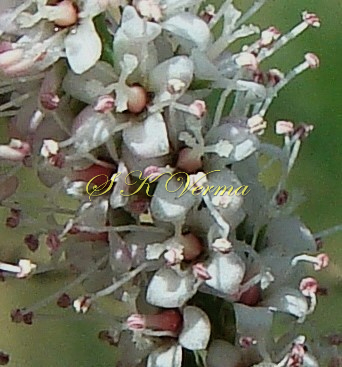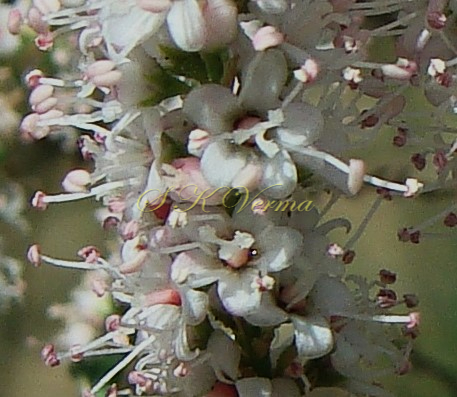TAMARIX
Tamarix L., Sp. Pl. 270. 1753; Gen. Pl. 5: 131. 1754; Ehrenberg, Linnaea 2: 241-344. 1827; DC., Prodr. 3: 95. 1828; Bunge, Tentamen 1-85. 1852; Boiss., Fl. Or. 1: 1763. 1867; Benth. & Hook. f., Gen. Pl. 1: 159. 1867; Dyer in Hook. f., Fl. Brit. India 1: 248. 1875; Parker, For. Fl. Punj. ed. 1:25. 1918 (Reprint 1973); Cooke, Fl. Pres. Bomb. 1: 74. 1958 (Reprinted ed.); Talbot, For. Fl. Bomb. Pres. and Sind, 1: 84. 1911; Baum, Monog. Genus Tamarix 22. 1966; Hutch., Gen. Fl. Pl. 2: 323. 1967; Fl. China @ eFloras.org 13: 59; Gaskin, Fl. North Amer. @ eFloras.org vol. 6; Qaiser, Fl. Pak. @ eFloras.org p. 2.
Shrubs or small trees, densely branched, bark mostly brownish to blackish brown. Branches of 2 types: i) ligneous growing branches, not deciduous in winter ii) green vegetative branchlets, deciduous in winter. Leaves alternate, sessile, amplexicaul or sheathing, small, 0.5-7 mm long, scale-like, mostly glabrous, covered with punctate, salt- secreting glands. Flowers in spikes, dense racemes or panicles, 1-15 cm long; racemes lateral on growing branches of previous or current year and clustered in terminal panicles; blooming in spring (vernal) or summer (aestival). Flowers small, bracteate, usually pedicellate, actinomorphic, bisexual, rarely unisexual, then plants dioecious, 5- or 4-merous. Calyx herbaceous or fleshy, 4- or 5-lobed, subequal or equal with imbricate aestivation: 2 outer, 3 inner or 2 outer, 2 inner, entire or denticulate, obtuse or acute. Petals 4 or 5, as many as calyx lobes, free, ovate, oblong, obovate or elliptical, apex obtuse or slightly notched, pink, violet, purple or white, deciduous or persistent. Stamens 4 or 5 (10-12), opposite to calyx lobes; filaments often free, inserted between or at apices of disk lobes; anthers cordate, versatile, bithecous, dehiscence longitudinal. Disk nectariferous, variously shaped, 4- or 5-lobed, lobes entire or apex retuse or even deeply divided. Pistil 1, 3-4-carpellate, syncarpous; ovary mostly conic, many-ovuled, placentation basal-parietal; styles 3 or 4, connate below; stigmas 3 or 4 (rarely 5 or 2), elongate, clavate, divergent. Fruits capsules, 3-5-angled, conical or pyramidal, dehiscing mostly by 3 valves, downward to base. Seeds small, compressed, glabrous, coma apical, sessile.
35 species
Tamarix indica
Tamarix indica Willd., Ges. Naturf. Freunde Berlin Neue Schriften 4: 214. 1803; Shetty & Pandey in Sharma & Sanjappa, Fl. India 3: 24. 1993; Qaiser, Fl. Pak. @ eFloras.org p. 5; T. benghalensis Baum, Monog. Rev. Genus Tamarix 78-79, 180, f. 30. 1966; T. gallica var. indica (Willd.) Ehrenb., Linnaea 2: 268. 1827.
Small tree, 1.5-6 m tall. Stem much branched, glabrous. Branches of 2 types: i) ligneous old growing branches, reddish brown, not deciduous in winter ii) young green vegetative branches, deciduous in winter. Leaves present on green branches, exstipulate, alternate, sessile, pseudovaginate, ovate with deltoid base, 1-3.5 mm x 0.5-1.6 mm amplexicaul, younger leaves imbricate without coherent margins, older leaves distant, apex acute to acuminate, mostly glabrous, covered with salt-secreting glands. Racemes lateral on growing branches of current or previous year, and clustered in terminal panicles; blooming in summer (aestival); racemes 3-8 cm x 3-4 mm. Bracts 1.5-2.5 mm long, usually ovate-lanceolate, acuminate, denticulate to subentire, reflexed. Pedicels ca. 0.5 mm long, much shorter than bract. Flowers small, actinomorphic, bisexual, 5-merous, hypogynous. Sepals 5, 2 outer and 3 inner, connate only at base, lobes 0.6-1 mm x 0.5-0.8 mm, subequal, inner somewhat broader than outer, ovate or trullate-ovate, margin somewhat membranous, upper half denticulate. Petals 5, free, 1.5-2 mm x 0.8-1 mm, obovate, oblong-elliptic or obovate-elliptic, apex obtuse or slightly notched, light pink, persistent. Stamens 5, free, opposite to calyx lobes, exserted; filaments filiform, 2.5- 3.5 mm long, mesodiscine; anthers ovoid, bithecous, subequal, apiculate, dehiscence longitudinal by slits. Disk 0.5-1 mm across, 5-lobed, notched. Ovary conical, trigonous, 3-4-locular, ovules many, basal parietal placentation; styles 3, connate below; stigmas 3, clavate, divergent.
Capules 3.5-4 x 1.3-1.5 mm, conical-triangular, 3-valved. Seeds numerous, ca. 0.6 mm across, coma apical, sessile, ca. 2.5 mm long. (Fruits not observed)
Common Names: Indian Tamarisk; Jhau (Hindi), Lai (Punjabi)
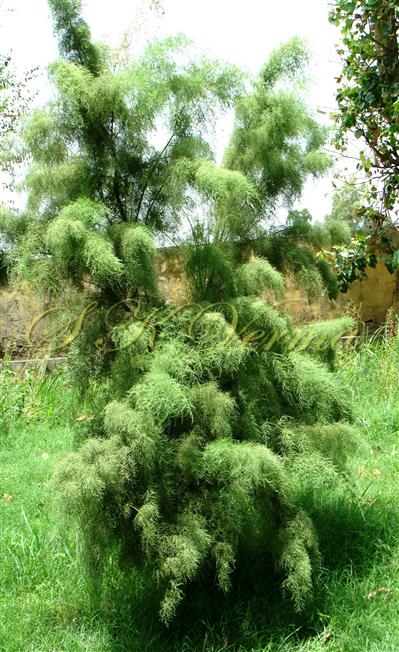
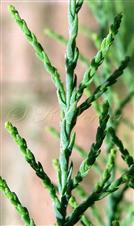

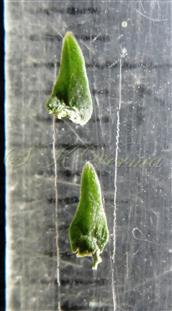
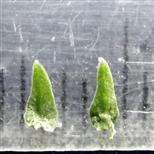
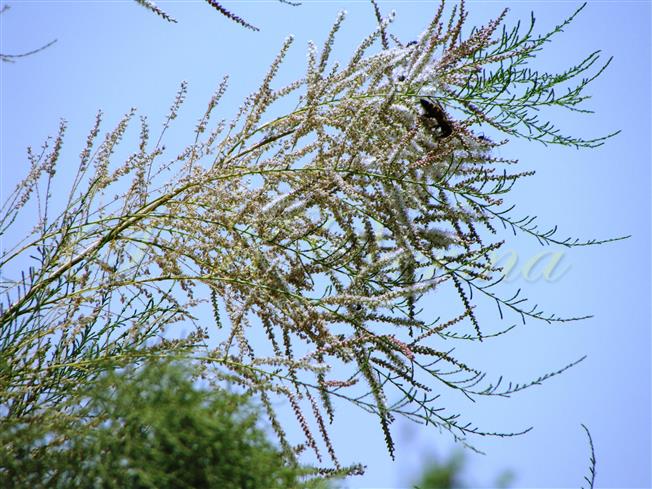
.jpg)
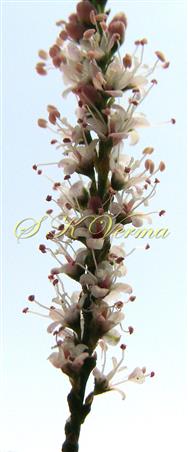

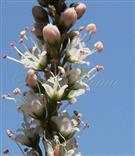


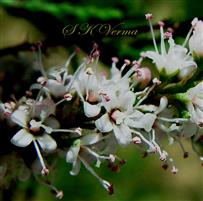
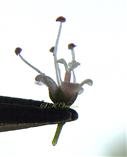



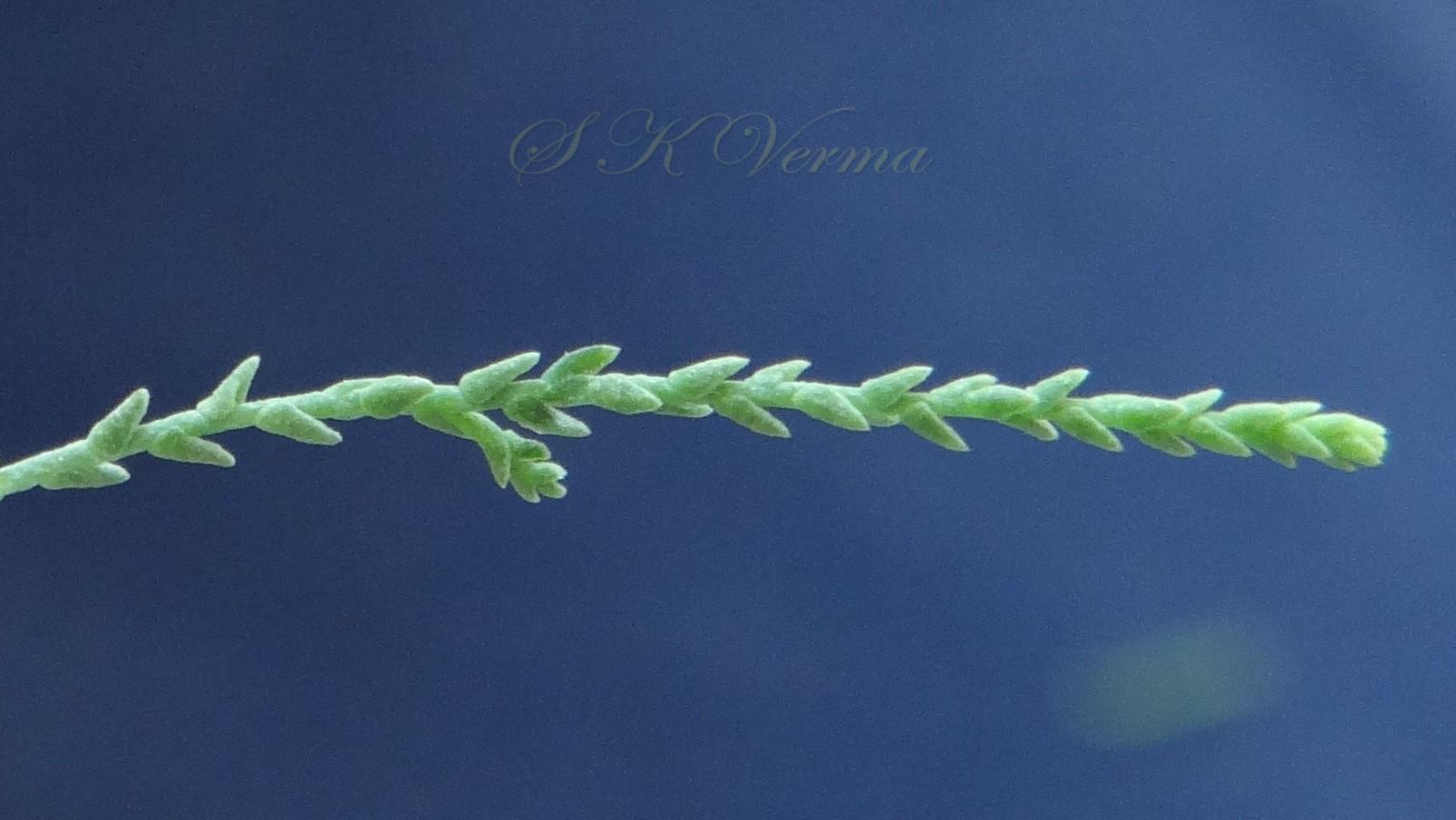



.jpg)



